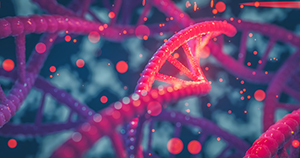The tumors of patients with stage I and II non–small cell lung cancer (NSCLC) demonstrated a generally higher tumor mutational burden and more often displayed the mutational signature associated with tobacco smoking than those of patients with more advanced disease, according to findings presented at the Molecular Analysis for Precision Oncology (MAP) Congress 2020 (Abstract 3MO).
First study author Guus Van den Heuvel, MD, of Radboud University Medical Center in Nijmegen, The Netherlands, remarked that recent studies have demonstrated varying therapeutic effects of immune checkpoint inhibitors in patients with NSCLC and high tumor mutational burden, prompting this study—which examined the link between high tumor mutational burden in a large series of clinical NSCLC samples, irrespective of tumor stage. Dr. Van den Heuvel and colleagues also aimed to identify the particular mutational processes involved by assessing mutational signatures.

Photo credit: Getty
Study Methods
In this retrospective, observational, descriptive study, investigators extracted DNA from cytologic samples and formalin-fixed, paraffin-embedded tissue sections of tumor samples obtained from patients with stages I, II, III, and IV NSCLC. DNA sequencing was performed using the TruSight Oncology 500 panel comprising 523 cancer-related genes. Tumor mutational burden was defined as the number of somatic mutations per megabase (mut/Mb) in each sample. Tumor samples containing a minimum of 30 somatic variants were utilized for mutational signature profiling.
Analysis Findings
Sequencing was performed on 197 samples. The median nonsynonymous tumor mutational burden was determined to be 8.7 mut/Mb (range = 0–85.4).
Compared with this median, stage I and II tumors had a median tumor mutational burden of 67%, compared to the median tumor mutational burden in stage III and IV tumors of 47.5% (P = .01).
Evaluation of mutational signatures was done in 76 (39%) tumor samples, with median tumor mutational burden of 15.2 mut/Mb. The single base substitution signature 4 (SBS4), which is associated with tobacco smoking, was present in 34 of 76 (45%) samples. The SBS4 signature was significantly more present in samples from patients with stage I and II disease compared with those with stage III and IV disease (P = .003).
The signatures SBS2 and SBS13, which are associated with activity of the AID/APOBEC family of DNA deaminases and may be linked to cancer development, were observed in 30 of 76 (39%) samples.
One tumor with a tumor mutational burden of 26 mut/Mb also harbored SBS7a and SBS7b signatures that are associated with ultraviolet light exposure.
The authors concluded that, in general, patients with early-stage NSCLC have a higher tumor mutational burden in comparison to those with more advanced-stage disease, and more often show a SBS4 signature, which is associated with tobacco smoking. They further advised that these findings may have clinical implications for a subpopulation of patients that may benefit from adjuvant immuno-oncology.
Disclosure: For full disclosures of the study authors, visit oncologypro.esmo.org.

